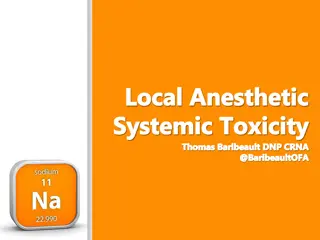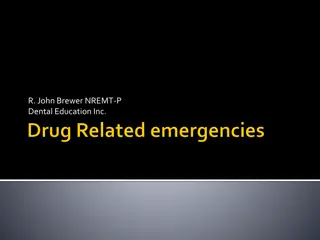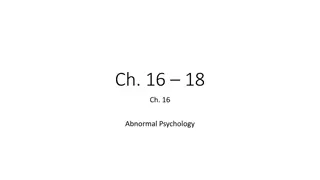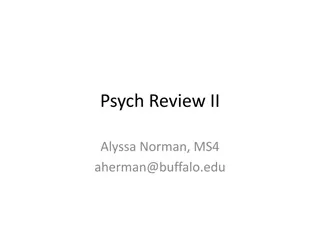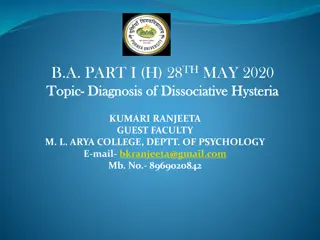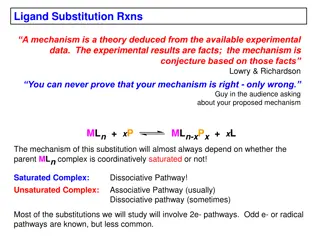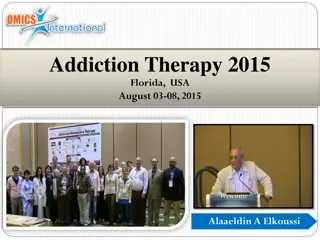Understanding Local Anesthetics: Mechanism, Characteristics, and Pharmacokinetics
Local anesthetics (LAs) block nerve impulse conduction effectively for pain management without motor blockade. Their chemistry, including lipophilic groups and ionizable groups, contributes to their efficacy. LAs have rapid onset, long duration, reversibility, and minimal side effects. Pharmacokinet
0 views • 30 slides
Understanding Local Anesthetic Systemic Toxicity in Anesthesia Practice
Local anesthetics are crucial in anesthesia for their ability to prevent nerve depolarization, but systemic toxicity can lead to serious complications. Last Causes, signs, and max dosage discussion along with the importance of recognizing early signs like lightheadedness, tinnitus, and late symptoms
0 views • 19 slides
Understanding Somatic Symptom Disorders, Conversion Disorders, and Dissociative Disorders
Somatic symptom disorders manifest as physical symptoms without apparent cause, while conversion disorders involve specific physical symptoms incompatible with medical conditions. Illness anxiety disorder involves interpreting normal sensations as disease symptoms. Dissociative disorders lead to a s
1 views • 41 slides
Understanding Ritual Abuse and Mind Control in Clinical Practice
Identifying ritual abuse and mind control in clients can be complex, with common indicators such as dissociative identity disorder and extreme trauma experiences. The Extreme Abuse Survey highlighted significant findings related to ritual trauma, including global prevalence, involvement in organized
0 views • 37 slides
Understanding Drug Administration in Dentistry: Safety and Considerations
Drug administration is common in dental practice, with categories including local anesthetics, analgesics, antibiotics, and CNS depressants. Safety, rational use, and principles of toxicology play vital roles in preventing adverse reactions and emergencies. Proper administration is crucial for effec
0 views • 76 slides
Understanding Local Anesthesia and Nerve Conduction Blockade
Local Anesthetics (LAs) are drugs that abolish sensations like pain in specific body areas by blocking nerve conduction of sensory impulses. This process involves reducing the influx of sodium ions, preventing membrane depolarization, and inhibiting action potential conduction. LAs are weak bases wi
0 views • 22 slides
The Use of Music and Auditory Stimuli in Psychological Therapy with Extreme Abuse Survivors
Extreme abuse survivors often find solace and emotional regulation through music and other auditory stimuli, which can evoke various responses such as containment, identity switching, and flashbacks. Despite being less discussed in clinical literature, these stimuli play a crucial role in therapy wi
0 views • 27 slides
Understanding Schizophrenia, Dissociation, and Borderline Personality Disorder
Clinical challenges and treatment approaches for schizophrenia, dissociative identity disorder, and borderline personality disorder are discussed in this content. The genetic and environmental factors influencing these conditions are explored, along with insights from twin studies and treatment effi
0 views • 23 slides
Buy Ketamine Rotex online - globaldrugsstore.com
Ketamine Rotex is a specific form of ketamine, a dissociative anesthetic that has been used in medical settings for decades. Initially developed as an anesthetic for surgeries, ketamine has since gained attention.\nText\/ WhatsApp: 1 (234) 738-2307\
1 views • 5 slides
Understanding General Anesthetics and Anesthesia
General anesthesia induces a reversible state of CNS depression, providing sedation, amnesia, muscle relaxation, reflex suppression, and analgesia. Preanesthetic medications prepare patients for the process, including antiemetics and anticholinergics. Anesthetics are delivered via inhalation or intr
0 views • 42 slides
Understanding Malignant Hyperthermia: Causes, Management, and Epidemiology
Malignant Hyperthermia (MH) is a genetic disorder of skeletal muscle triggered by certain anesthetics, leading to a hyper-metabolic state. The uncontrolled release of calcium results in muscle rigidity, metabolic acidosis, hyperthermia, and other serious complications. MH was first described in the
0 views • 24 slides
Understanding Ketamine: Effects, Risks, and Harm Reduction
Ketamine is a dissociative and psychedelic drug that can induce hallucinations and detachment from reality. It is used as an anaesthetic but can lead to short-term effects like euphoria and detachment, with long-term risks including depression and bladder damage. Mixing with other substances poses a
0 views • 10 slides
Understanding Abnormal Psychology: Disorders, Symptoms, and Treatments
Explore the world of abnormal psychology through the lens of different disorders like depression, anxiety, and phobias. Learn about the definitions of abnormal behavior, DSM-V classifications, and various types of psychological disorders. Delve into the complexities of mental health conditions such
0 views • 39 slides
Understanding Substance Use Disorders and Their Effects
Alyssa Norman, MS4, provides a comprehensive review of intoxication and withdrawal patterns in substance use disorders, highlighting impaired control, social impairment, risky use, and pharmacologic dependence. The content covers various substances, mechanisms of action for stimulants, symptoms of i
0 views • 35 slides
Understanding Diagnosis and Treatment of Dissociative Hysteria in Psychology
The diagnosis of dissociative hysteria involves careful consideration to differentiate from organic illness. Factors such as emotional stress, time relationship with stress onset, symbolic meaning of symptoms, and course of symptoms in response to treatment play key roles in diagnosis. Psychotherapy
0 views • 6 slides
Study on Plasma Facing Surface Materials in Nuclear Engineering at NC State University
This research at NC State University's Department of Nuclear Engineering focuses on the effects of plasma facing surface materials on low-pressure pulsed plasma characteristics. The study delves into topics such as electron sources, secondary emission, dissociative recombination, modeling results, c
0 views • 31 slides
Understanding Ligand Substitution Reactions in Metal Complexes
Ligand substitution reactions in metal complexes involve the replacement of one ligand with another, impacting the coordination around the metal center. The mechanism of these reactions, associative or dissociative, is influenced by factors like coordination saturation and electron count. Experiment
0 views • 20 slides
Understanding Mental Health Disorders and Their Impact
Mental health disorders are prevalent, affecting 1 in 5 adults in the U.S. each year. They can significantly impair various aspects of life and lead to severe consequences, including high costs, hospitalizations, homelessness, and incarceration. Factors contributing to mental illness vary from biolo
0 views • 54 slides
Understanding Inhalant Abuse: Risks, Effects, and Prevention
Inhalant abuse is a widespread issue, with volatile substances being inhaled to achieve psychoactive effects. This form of substance abuse poses significant toxicological and social hazards, often affecting marginalized populations such as neglected street children. The accessibility, affordability,
0 views • 44 slides
Exploring the World of Esterification: Aromatic Fragrances to Pharmaceutical Applications
Esterification is a versatile chemical process that yields compounds with pleasant odors and diverse applications, from fragrances like banana and peppermint to pharmaceuticals like local anesthetics. The process involves reactions such as Fischer Esterification and Schotten-Baumann Esterification,
0 views • 21 slides
Understanding Local Analgesia and Anesthesia: Types and Mechanisms Explained
Local analgesia and anesthesia involve desensitizing a specific area of the body through various methods such as surface analgesia, nerve blocks, and regional analgesia. These techniques rely on either ester-linked or amide-linked compounds with different potencies and durations of action. The best-
0 views • 12 slides

